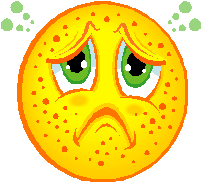 Springtime is often chickenpox time. This common childhood disease, usually found in children aged 4-10, causes itchy spots to appear all over the body and is highly contagious, but unfortunately has a 10-21 day incubation period and a 1-2 day period where there are no symtoms, meaning it spreads very easily. The virus can be airborne, in droplets from coughs and sneezes, and found in the liquid that fills the blisters of the characteristic rash. Signs usually appear 10 days after exposure but it can be as long as 3 weeks.
Springtime is often chickenpox time. This common childhood disease, usually found in children aged 4-10, causes itchy spots to appear all over the body and is highly contagious, but unfortunately has a 10-21 day incubation period and a 1-2 day period where there are no symtoms, meaning it spreads very easily. The virus can be airborne, in droplets from coughs and sneezes, and found in the liquid that fills the blisters of the characteristic rash. Signs usually appear 10 days after exposure but it can be as long as 3 weeks.
Children may feel unwell or irritable, have a fever or achy muscles and lose their appetite. The rash usually appears first on the inside of the mouth and at the back of the throat before covering the head and body. It starts as small red pinpicks which turn to fluid filled blisters within 10-12 hours. The itchy blisters then scab over but more may appear for up to 5 days.
There is no cure for chickenpox, although there is a vaccine available, but most parents prefer to let their children catch it. The only thing you can do is try to relieve itching and prevent complications such as infection that come from scratching. The most common remedy is calamine lotion which is applied to the spots. It’s a good idea to cut nails short or wear gloves to make it difficult to scratch. Other remedies are filling a sock or pair of tights with porridge oats and putting it in the bath or adding sodium bicarbonate to the bathwater. If the rash doesn’t heal after a week or some spots appear to be growing an infection may have set in such as impetigo. Children often don’t feel like eating or drinking because the inside of their mouth is sore so offer plain or fruit ice lollies to soothe and combat dehydration.
It’s unusual for adults to catch chicken pox as most people have had it in childhood, but the virus can cause shingles so good hygiene is vital. Wash your hands frequently and bleach surfaces
The frustrating thing about chickenpox is often being cooped up indoors. It is very contagious and although often mild in children it can be serious in pregnant women and the elderly so going out and about is not advised. Children often feel perfectly well apart from the itching and find being kept inside frustrating. Sensory play can be a great way to distract children from the itching and incorporate treatment. Why not try body art with calamine lotion or water play in a soothing bath? Keeping hands busy gives them less chance to scratch and as it’s springtime get a head start on Easter with 9 nifty Easter activities or check out some previous suggestions for rainy day play.

